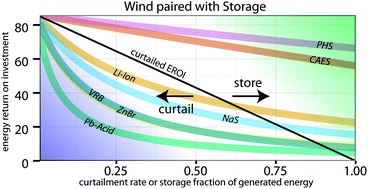The energetic implications of curtailing versus storing solar- and wind-generated electricity†
Abstract
We present a theoretical framework to calculate how storage affects the energy return on energy investment (EROI) ratios of wind and solar resources. Our methods identify conditions under which it is more energetically favorable to store energy than it is to simply curtail electricity production. Electrochemically based storage technologies result in much smaller EROI ratios than large-scale geologically based storage technologies like compressed air energy storage (CAES) and pumped hydroelectric storage (PHS). All storage technologies paired with solar photovoltaic (PV) generation yield EROI ratios that are greater than curtailment. Due to their low energy stored on electrical energy invested (ESOIe) ratios, conventional battery technologies reduce the EROI ratios of wind generation below curtailment EROI ratios. To yield a greater net energy return than curtailment, battery storage technologies paired with wind generation need an ESOIe > 80. We identify improvements in cycle life as the most feasible way to increase battery ESOIe. Depending upon the battery's embodied energy requirement, an increase of cycle life to 10 000–18 000 (2–20 times present values) is required for pairing with wind (assuming liberal round-trip efficiency [90%] and liberal depth-of-discharge [80%] values). Reducing embodied energy costs, increasing efficiency and increasing depth of discharge will also further improve the energetic performance of batteries. While this paper focuses on only one benefit of energy storage, the value of not curtailing electricity generation during periods of excess production, similar analyses could be used to draw conclusions about other benefits as well.


 Please wait while we load your content...
Please wait while we load your content...